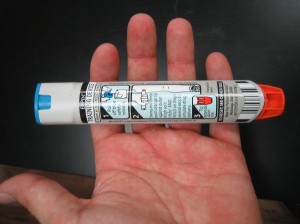Individuals who have allergies develop mild to moderate symptoms such as runny nose, watery eyes or a rash. Oftentimes, exposure to an allergen can lead to a life-threatening reaction called as anaphylaxis. This severe reaction occurs once the body releases chemicals that send the individual into a state of shock. Allergies to insect stings, food, latex and medications are usually linked with anaphylaxis.
A second anaphylactic reaction called as biphasic reaction can occur as long as 12 hours after the initial reaction.
It is vital to call for emergency assistance and bring the individual to the nearest healthcare facility upon the first sign of anaphylaxis even if epinephrine has been administered. Remember that just because an individual has not experienced an anaphylactic reaction in the past to an offending allergen, it does not mean that one will not occur in the future. If an individual experienced an anaphylactic reaction in the past, he/she is at risk for future reactions.
Symptoms
The symptoms of anaphylaxis occur abruptly and progress rapidly. The early symptoms are mild which includes runny nose, skin rash or a strange feeling. These symptoms can rapidly lead to serious issues which includes the following:

- Hives
- Difficulty breathing
- Nausea
- Tightness of the throat
- Hoarse voice
- Vomiting
- Diarrhea
- Abdominal pain
- Dizziness
- Fainting
- Rapid heart rate
- Low blood pressure
- Feeling of doom
- Cardiac arrest
An individual who experiences a severe allergic reaction are at risk for future reactions. Even if the initial reaction is mild, the future reactions might be severe. This is why it is vital to bring an epinephrine injection at all times if the individual is at risk and call for emergency assistance right away.
Management
Anaphylaxis must be treated immediately with an epinephrine injection. Remember that two injections might be required to manage the symptoms. There are important tips to bear in mind to minimize the risk of anaphylaxis.
- The individual should determine the triggers. If an individual had anaphylaxis, it is vital to know the trigger. The common triggers include certain foods, latex, insect stings and medications.
- Avoidance of the known triggers. This is the most effective way to prevent anaphylaxis. Working with an allergist is recommended to develop specific measures.
- Being prepared at all times by prompt recognition of the signs and symptoms. If an individual was unexpectedly exposed to a trigger, an emergency plan outlined by the doctor must be followed. In case there are doubts about the reaction, it is advised to administer epinephrine.
- In case a severe reaction occurs and epinephrine is administered, the individual should be taken to the nearest healthcare facility for further assessment and treatment.
- Family and friends should be aware of the condition, triggers and how to recognize the anaphylactic symptoms. If the individual has an epinephrine injection, they should be aware where it is stored and how to use it.
- The individual should use an identification bracelet or necklace which informs others of his/her condition.
